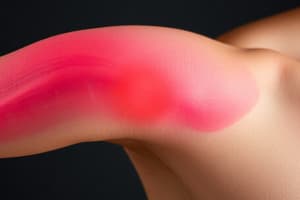Podcast
Questions and Answers
What is the first immune response that occurs during muscle strain repair?
What is the first immune response that occurs during muscle strain repair?
- T-lymphocytes dominate the inflammatory process
- Neutrophils are the first on the scene (correct)
- Cytokines are released to promote healing
- Macrophages migrate to the injury site
What initiates the inflammation phase after a muscle injury?
What initiates the inflammation phase after a muscle injury?
- Hemostasis and hematoma formation
- Proliferation of satellite cells
- Release of chemotactic agents (correct)
- Formation of the basement membrane
What is one of the consequences of an intact basement membrane during muscle repair?
What is one of the consequences of an intact basement membrane during muscle repair?
- Greater necrosis in the area
- Reduced risk of muscle re-injury
- Increased fibrosis
- Enhanced muscle regeneration (correct)
How long after injury does regeneration of muscle typically begin?
How long after injury does regeneration of muscle typically begin?
Which cytokine effect primarily contributes to the fusion of myogenic cells to myofibers?
Which cytokine effect primarily contributes to the fusion of myogenic cells to myofibers?
What does the term 'fibrosis' refer to in muscle injury repair?
What does the term 'fibrosis' refer to in muscle injury repair?
During the muscle healing process, what is the role of T-lymphocytes?
During the muscle healing process, what is the role of T-lymphocytes?
What is the potential effect of cytokines on oxidative stress during muscle repair?
What is the potential effect of cytokines on oxidative stress during muscle repair?
What is a key role of satellite cells in muscle healing?
What is a key role of satellite cells in muscle healing?
Flashcards are hidden until you start studying
Study Notes
Muscle Injury: Repair and Regeneration
- Hemostasis and hematoma formation: Immediately following injury, blood clots form, leading to a hematoma (blood collection)
- Degeneration:
- Necrosis: Damaged muscle fibers die off. Neutrophils (white blood cells) arrive first to clean up debris.
- Chemotactic agents: These chemicals signal other inflammatory cells to the injury site.
- Inflammation:
- Timeline: Starts 24-48 hours post-injury.
- Phagocytosis: Macrophages (white blood cells) engulf cell debris.
- Satellite Cell Activation: Macrophages stimulate satellite cells to:
- Migrate: Move to the injury site.
- Differentiate: Transform into muscle precursor cells.
- Cytokine Release: Release various chemical signals.
- T-Lymphocyte Dominance: After macrophages subside, T-lymphocytes take over, also releasing cytokines.
- Regeneration:
- Timeline: Begins around 6-8 weeks following injury.
- Remodeling: New muscle fibers mature and rearrange.
- Fibrosis (Scar Tissue Formation):
- Potential Outcome: May occur, but not always.
- Consequences: Fibrous tissue is less functional than muscle tissue, increasing re-injury risk.
The Importance of Basement Membrane
- Essential for Regeneration: An intact basement membrane is critical for new muscle fiber formation.
- Satellite Cell Division: Satellite cells divide and fuse with remaining muscle fibers or other myogenic cells.
- Fibrosis if Basement Membrane Damaged:
- Structural Integrity: Fibrous tissue provides some structure but lacks the function of healthy muscle.
- Increased Re-injury Risk: Scar tissue is weaker than muscle tissue, making the area more susceptible to further damage.
Cytokine Effects on Muscle Repair
- Enhanced Resistance to Oxidative Stress: Promotes cell survival.
- Block Myofibrogenesis: Suppresses the formation of fibrous tissue, improving muscle healing quality.
- Proliferation: Stimulates satellite cells to divide, increasing the pool of muscle precursor cells.
- Differentiation: Triggers satellite cell differentiation into muscle fibers.
- Angiogenesis: Promotes the growth of new blood vessels, delivering vital nutrients and oxygen to the regenerating muscle.
Studying That Suits You
Use AI to generate personalized quizzes and flashcards to suit your learning preferences.




